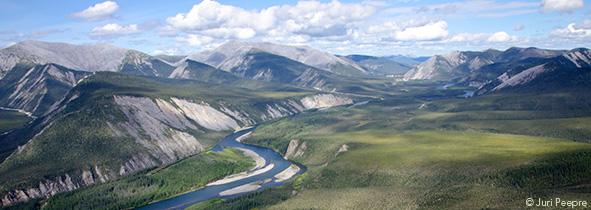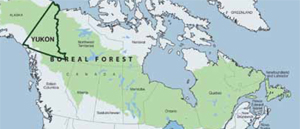Provincial and Territorial Forest Facts
Explore Canada's Boreal Forest by Province and Territory to see what makes each part of the boreal forest special.
Choose a province or territory:
Yukon


Yukon's Boreal Forest:
- is 465,000 km2 (115 million acres) in size – larger than Sweden.1
- comprises 8% of Canada's Boreal forest.
- is home to approximately 15 aboriginal communities.2
- is home to the Common Raven, Yukon's official bird, and the Subalpine Fir, the official tree.
- stores 7 billion tonnes of carbon in its soils, peat, and forests, equivalent to around 35 years' worth of Canada’s GHG emissions in CO2 equivalent at 2014 levels.3
- contains the Yukon River, the 5th-longest river in North America; it flows through Yukon, British Columbia and Alaska and is 3,200 km long. The Yukon River is considered one of the wildest and longest free-flowing rivers in North America. With its vast, undammed reaches, it supports healthy populations of economically and ecologically important Chinook and Coho salmon, anadromous Bering cisco, whitefish, Arctic grayling, and resident Lake trout, Northern pike and Dolly varden.4
- is the breeding ground for 80 to 240 million birds of more than 150 bird species, including Olive-sided Flycatcher, Blackpoll Warbler, Smith's Longspur and Rusty Blackbird.
- supports over 120,000 Barren ground caribou, as well as large populations of wolves, bear, moose, mountain sheep and other wildlife.5
- features 450,000 km2 (111 million acres) of intact forest, peatland and wetland habitat free from industrial development, making up 95% of the province's boreal region.6
1 Canadian Boreal Initiative. 2003. Canada's Boreal Region.
2 Aboriginal Canada Portal (www.aboriginalcanada.gc.ca) and Global Forest Watch.
3 Tarnocai, C. and Lacelle, B. 1996. Soil Organic Carbon Digital Database of Canada. Eastern Cereal and Oilseed Research
Center, Research Branch, Agriculture and Agri-Food Canada, Ottawa, Canada.
4 Benke, A., and Cushing, C. Rivers of North America. 2005.
5 The CircumArtic Rangifer Monitoring & Assessment Network. Accessed August, 2009. www.carmanetwork.com
6 Global Forest Watch Canada. 2009. Canada's Forest Landscape Fragments: A Second Approximation.

